
Beautiful Camellias for Every Garden – Varieties & Care Tips
Published: 06/08/2024 | Updated: 01/04/2025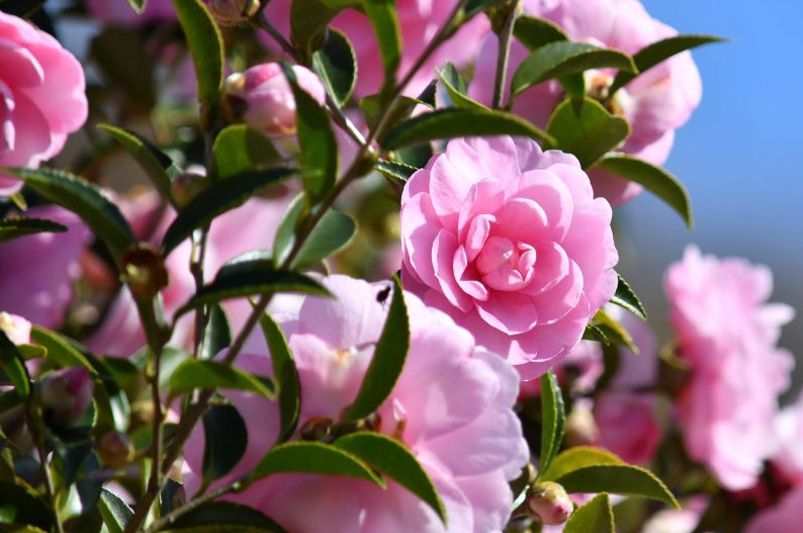
Few plants can match the timeless elegance of Camellias. With their lush evergreen foliage and stunning blooms that brighten gardens from fall to spring, these versatile shrubs add year-round charm to any landscape. Whether you’re looking to create a classic hedge, enhance a shaded corner, or even grow your own tea, Camellias are a must-have for gardeners of all levels.


At ShrubHub, we offer a breathtaking selection of Camellias, from the deep red Black Magic Camellia Japonica to the delicate white Camellia Mine No Yuki. With nationwide delivery and expert garden design services, transforming your outdoor space has never been easier.
Want more expert gardening tips? Check out our weekly blog for the latest insights on plant care, landscape design, and seasonal gardening advice!
Popular Camellia Varieties
Camellias come in a stunning array of colors, sizes, and bloom times, making them an essential addition to any landscape. Whether you’re looking for a bold statement shrub or a delicate flowering accent, these varieties offer something for every garden.
Autumn Sentinel Camellia Sasanqua
The Autumn Sentinel Camellia is an evergreen shrub known for its upright, columnar growth habit and elegant blooms. It produces an abundance of semi-double to peony-form pink flowers from late fall through early winter, adding vibrant color to the cooler months. Ideal for hedges, screens, or accent planting, this Camellia variety features glossy, dark green foliage and thrives in partial shade with well-drained, acidic soil. Its narrow form makes it a great choice for smaller gardens or vertical interest in the landscape.
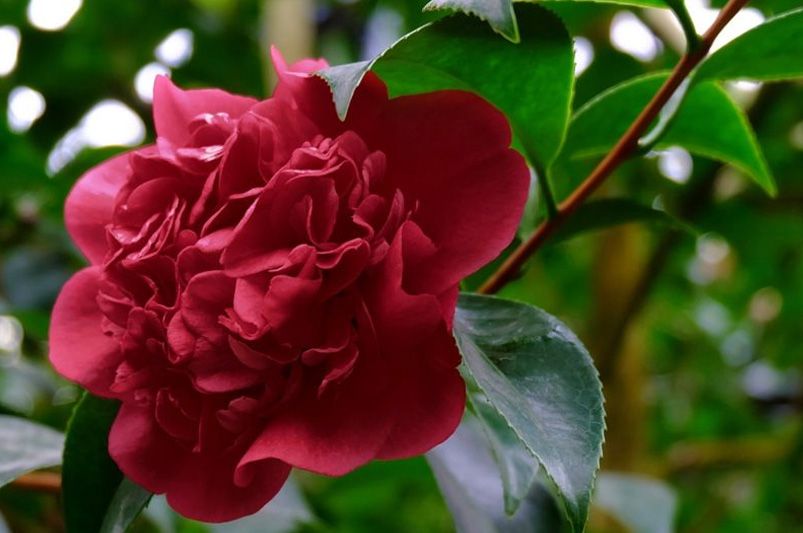
Black Magic Camellia Japonica
The Black Magic Camellia Japonica is a striking evergreen shrub prized for its dramatic, deep red to nearly black semi-double blooms that appear from late winter to early spring. Its glossy, dark green foliage provides a lush backdrop for the velvety flowers, creating a bold statement in the garden. With a compact, upright growth habit, it’s well-suited for use as a specimen plant, in borders, or in shaded garden beds. This Camellia thrives in acidic, well-drained soil and partial shade.
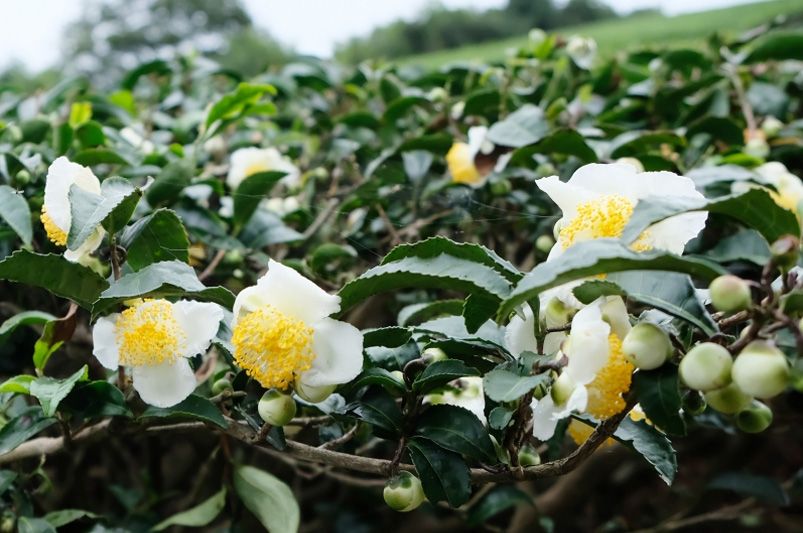
Brew-tea-ful Plant Camellia Sinensis
The Brew-tea-ful Plant Camellia sinensis is a charming evergreen shrub best known as the source of traditional tea leaves. It features small, fragrant white flowers with yellow centers in fall, complemented by glossy, dark green foliage. This compact, bushy plant is ideal for edible gardens or ornamental borders. The young leaves can be harvested and dried to make green, black, or oolong tea. Thriving in partial shade and well-drained, acidic soil, it’s both a beautiful and functional addition to the garden.
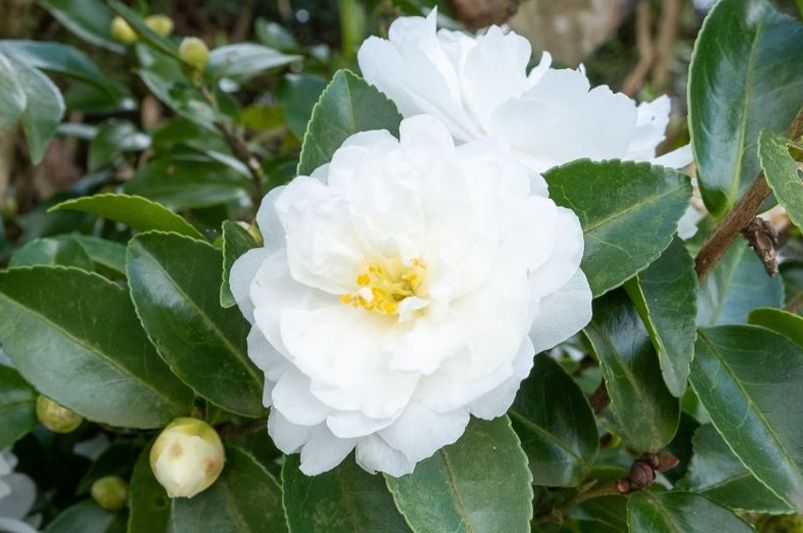
Camellia Dwarf White
The Camellia Dwarf White is a compact, evergreen shrub that produces delicate, pure white blooms from late fall through early spring. Its small, rounded form and glossy dark green foliage make it perfect for containers, borders, or small garden spaces. Despite its petite size, it offers a stunning floral display and adds elegance to shaded areas. Like other camellias, it prefers acidic, well-drained soil and partial shade.
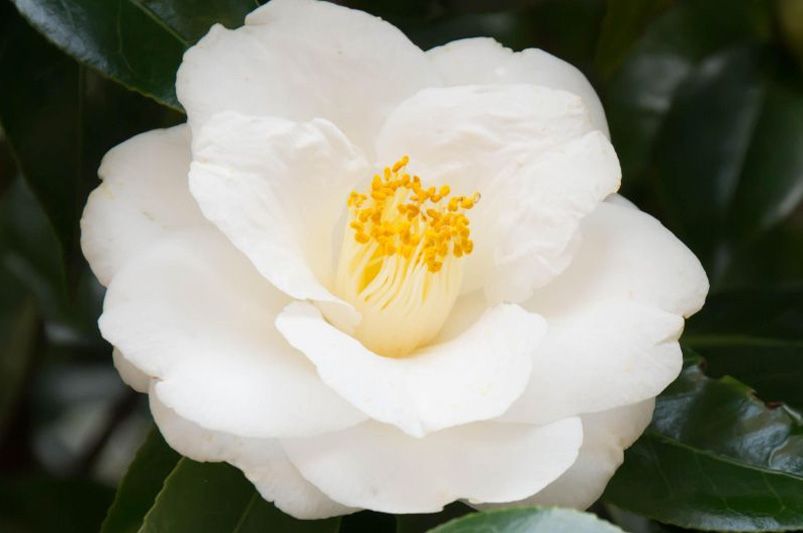
Camellia Mine No Yuki
The Camellia sasanqua 'Mine-no-Yuki', also known as 'White Doves' or 'Snow on the Ridge,' is an evergreen shrub celebrated for its abundant, pure white double blooms that appear from fall into early winter. These lightly fragrant flowers contrast beautifully against its glossy, dark green foliage. The plant exhibits a spreading, willowy growth habit, typically reaching heights and widths of 6 to 8 feet. It thrives in partial to full sun and prefers moist, well-drained, acidic soils. 'Mine-no-Yuki' is versatile in the landscape, suitable for use as a specimen plant, in mixed borders, as a low hedge, espalier, or even in large containers.
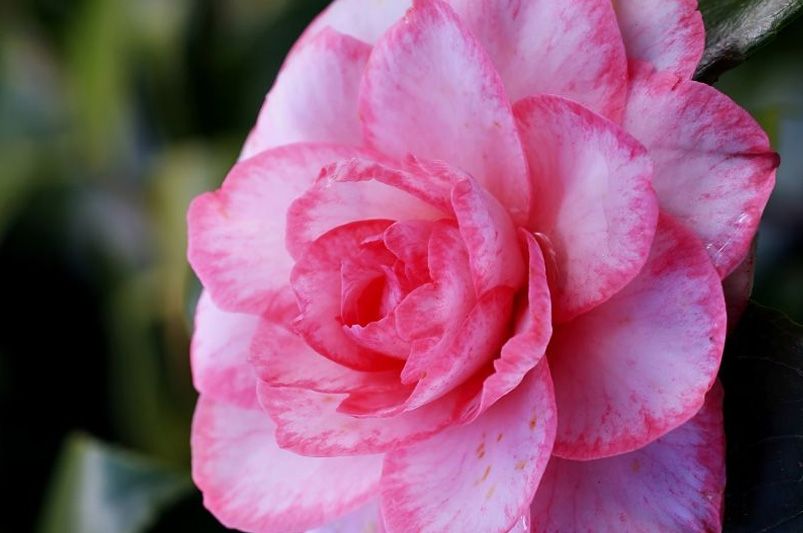
Camellia Leslie Ann
The Camellia sasanqua 'Leslie Ann' is an evergreen shrub admired for its elegant, semi-double white flowers edged with lavender-pink hues, blooming from late fall to early winter. Its glossy, dark green foliage provides year-round interest, and its upright growth habit allows it to reach heights of 7 to 10 feet and widths of 4 to 5 feet. 'Leslie Ann' thrives in partial shade with well-drained, acidic soil, making it a versatile choice for hedges, screens, or specimen plantings. Notably, this cultivar received the Ralph Peer Sasanqua Award in 1961, highlighting its exceptional qualities.
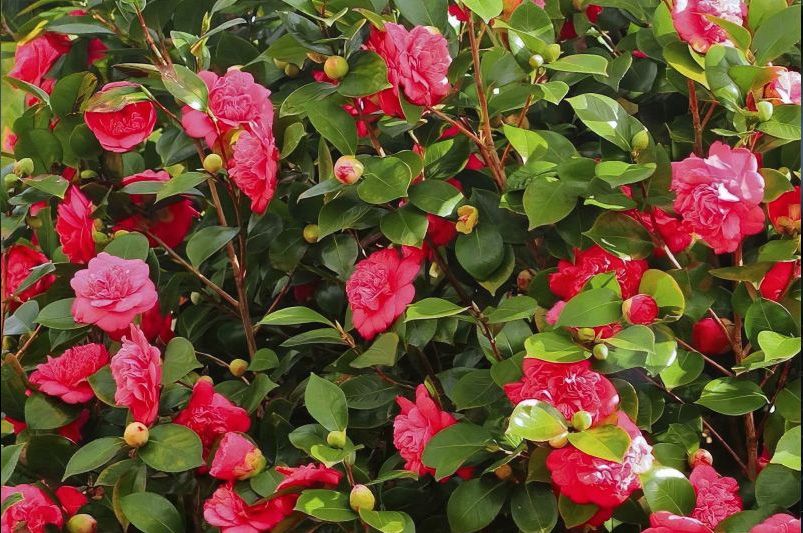
Camellia Red Twister
The Camellia 'Red Twister' is an evergreen shrub renowned for its unique, spiraling red blooms that add a striking visual element to any landscape. Blooming from late winter through spring, its vibrant flowers contrast beautifully with the glossy, dark green foliage. This variety typically reaches a mature height of 6 to 12 feet and a width of 6 to 10 feet, making it suitable for use as a foundation plant, hedge, or specimen shrub. 'Red Twister' thrives in partial shade and well-drained, acidic soil, flourishing in USDA hardiness zones 7 through 9.
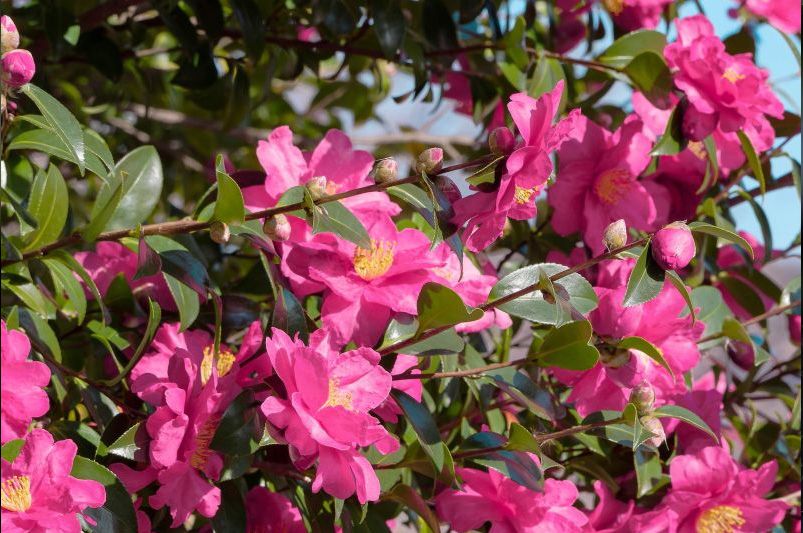
Camellia Rose of Autumn
The Camellia sasanqua 'Rose of Autumn' is an evergreen shrub celebrated for its vibrant, deep rose-pink double flowers that bloom from early to mid-fall. Its glossy, dark green foliage provides a striking contrast to the blossoms, enhancing its visual appeal. This vigorous, upright grower typically reaches heights of 6 to 8 feet and widths of 4 to 6 feet, making it an excellent choice for hedges, screens, or specimen plantings. Notably, 'Rose of Autumn' is recognized for its cold hardiness, with some reports indicating success in USDA Zone 6. It thrives in well-drained, acidic soil and prefers partial shade, though it can tolerate morning sun with afternoon shade. This cultivar was developed by Robert Green Jr. in Fairhope, Alabama, and first bloomed in 1994.
How to Plant and Care for Camellias
Camellias are prized for their elegant blooms and glossy green foliage, but to truly thrive, they require proper planting and care. Follow these essential guidelines to ensure your camellias stay healthy and produce abundant flowers year after year.
Ideal Growing Conditions
Camellias prefer specific conditions to flourish, so choosing the right location is key:
- Well-Draining Soil: Camellias thrive in slightly acidic, well-draining soil. Heavy clay or compacted soil can lead to root rot, so consider adding organic matter like peat moss or pine bark to improve drainage.
- Partial Shade: While camellias can tolerate some sun, they prefer dappled light or morning sun with afternoon shade. Too much direct sunlight can scorch leaves, while too much shade may result in fewer blooms.
- Protection from Harsh Winds: Strong winds can damage buds and dry out the foliage. Planting camellias near a fence, wall, or other windbreak can help shield them from harsh conditions.
Watering & Mulching
Camellias need consistent moisture, especially during their first year of establishment and the blooming season. However, overwatering can be detrimental.
- Watering Tips:
- Water deeply once or twice a week, depending on weather conditions.
- Allow the soil to dry slightly between waterings but avoid prolonged dryness.
- Use a soaker hose or drip irrigation to prevent wetting the leaves, which can lead to fungal diseases.
- Mulching for Root Protection:
- Apply a 2–3 inch layer of mulch (pine bark, wood chips, or compost) around the base of the plant to retain moisture, regulate soil temperature, and suppress weeds.
- Keep mulch a few inches away from the trunk to prevent rot.
Pruning & Maintenance
Regular pruning enhances the shape, encourages new growth, and improves air circulation, reducing disease risk. However, pruning at the wrong time may remove next season’s flower buds.
- Best Time to Prune: The ideal time for pruning camellias is right after blooming, typically in late winter or early spring. This prevents cutting off future flower buds.
- How to Prune:
- Remove dead, damaged, or weak branches to maintain plant health.
- Thin out crowded areas to improve air circulation.
- Lightly shape the plant to encourage bushier growth.
- Deadheading Spent Blooms: Removing faded flowers prevents the plant from wasting energy on seed production, encouraging more blooms the following year.
Fertilization Tips
Proper feeding ensures healthy foliage, strong root systems, and abundant flowers.
- Choosing the Right Fertilizer:
- Use a slow-release, balanced fertilizer formulated for acid-loving plants (such as azalea and camellia fertilizer).
- Organic options like cottonseed meal or fish emulsion are great for long-term soil health.
- When to Fertilize:
- Apply fertilizer in early spring, just before new growth starts.
- A second application in mid-summer can support continued development, but avoid late-season fertilizing, as it may encourage tender growth that’s vulnerable to frost.
- Application Tips:
- Sprinkle the fertilizer evenly around the drip line (not directly at the base) and water thoroughly to help nutrients reach the roots.
- Avoid over-fertilizing, as excessive nitrogen can promote leaf growth at the expense of flowers.
Landscaping with Camellias
Camellias are more than just elegant flowering shrubs—they are versatile plants that can enhance any landscape design. Whether you need a natural privacy screen, a stunning container plant, or a way to create a lush, layered garden, camellias can do it all.
Hedges & Privacy Screens
For homeowners looking to create a dense, evergreen barrier, tall camellia varieties like Autumn Sentinel Camellia make excellent natural hedges. Their upright growth habit and lush foliage provide year-round privacy while adding seasonal interest with their vibrant pink blooms. When planted in a row, camellias form a living fence that not only blocks unwanted views but also softens harsh lines in the landscape.
To achieve a full, lush hedge, space camellias about three to five feet apart, allowing them to grow into one another over time. Regular pruning after blooming encourages denser foliage, ensuring maximum coverage and an elegant, manicured appearance.
Container Gardening
Not all gardens have the space for large shrubs, but compact camellia varieties like Camellia Dwarf White are perfect for container gardening. Whether placed on a patio, balcony, or entryway, these camellias bring year-round greenery and seasonal blooms to smaller outdoor spaces. Their slow growth and manageable size make them ideal for decorative pots, where they can serve as a focal point in your outdoor décor.
To keep container-grown camellias healthy, use a well-draining potting mix and choose a container with adequate drainage holes. Water regularly, especially during dry spells, but avoid overwatering, as camellias dislike soggy roots. A layer of mulch on top of the soil helps retain moisture and regulate temperature.
Companion Planting
Camellias pair beautifully with a variety of plants, creating a layered and visually interesting garden. Their glossy green leaves and vibrant flowers provide the perfect contrast to shade-loving companions like azaleas, ferns, and hostas. These plants share similar growing conditions, thriving in partial shade and acidic soil, making them natural partners in the landscape.
Azaleas enhance the garden with their bright spring blooms, while ferns and hostas add texture and greenery beneath taller camellias. For an added burst of seasonal interest, plant camellias alongside bulbs like daffodils and tulips, which bloom early in the year before camellias take center stage.
By incorporating camellias into your landscape design, you can enjoy year-round beauty, structural elegance, and a garden that thrives with minimal effort. Explore ShrubHub’s wide selection of camellias to find the perfect variety for your outdoor space.
Conclusion
Camellias bring timeless beauty, elegance, and year-round greenery to any garden, whether used for privacy, containers, or vibrant seasonal color. With ShrubHub’s wide selection of premium camellias, expert 3D design services, and nationwide shipping, transforming your landscape has never been easier. Shop now and take advantage of exclusive discounts, free shipping on orders over $150, and personalized garden consultations to create the perfect outdoor oasis!


